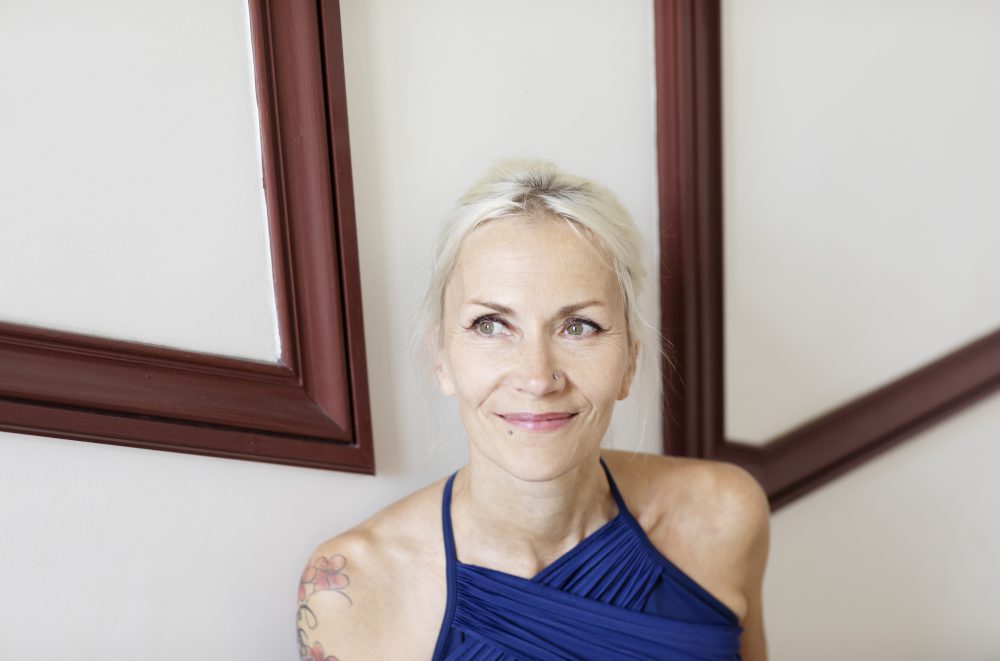When I took my first yoga classes twenty years ago, I immediately knew I had got a suitable tool for the rest of my life. I didn’t feel my first teachers shared my yoga experience and so from the very beginning I was alone with my practice. It didn’t matter. I knew what I had to do.
At that time I was living in Paris and I happened to find one yoga book of André Van Lysebeth. I devoured it and then I read all his books. I read every word and line with my heart. I was so fascinated by his generosity. He explained and desribed with small nuances about his own experience no matter if it was about the body, energy, nature or the practices. The text was magical, overflowing and alive. I believe I got deeply inspired and influenced by his texts for many years. It felt even that he transmitted his experience to me. His paternal and spiritual touch was like if someone really took my hand and guided me, opened new windows and doors – inside of me. I consider André Van Lysebeth my first yoga teacher.
I saw pictures of his yoga classes and they took my breath away – the atmosphere was so concentrated, authentic and delicate – it was yoga! These pictures in my mind I kept dreaming about this kind of place to practice in, where the silence, the devotion, the concentration and the connection between the practitioners reign. I have had the possibility to practice under Guruji’s guidance in the Lakshmipuram’s old shala in Mysore, India. It was something really unique, because of Guruji, but also because only twelve people could fit in. Guruji is the most important teacher for me. Still in Mysore I’ve felt that the hype and the emotional excitement around the teacher(s) disturbs the practice. People can be aggressive and blind, because they get so emotional.
Last year I met Patrick Frapeau in Mysore and we became friends. This year he started the Mysore morning classes in Paris where I live. Now that I can practice every morning in his presence, I feel my dream has come true. Thanks to him the space of the yoga shala is filled with the serenity and a deep, soft breathing. Everybody does his/her practice independently and with almost no loss of concentration, like bursts into laughter or little screams. The shala is like a small temple. Patrick is connected to everybody. He brings his warmheartedness, his care, his tenderness and joy to every gesture. No stress, no forcing, just love. I’m profoundly grateful to get help that starts from the real presence, the connection in the energy level and without any need to prove anything. What counts for me also, is that my teacher has a daily practice, he follows the tradition and he regularly goes to Mysore to practice. In this kind of subtle communication new energies emerge and the body finds new dimensions. I’m humbly thankful for this opportunity every day.
I warmly recommend Patrick’s teaching: http://www.patrickfrapeauyoga.fr/
UN TEMPLE À PARIS
Quand j’ai commencé à pratiquer le yoga, il y a vingt ans, j’ai tout de suite su que j’avais trouvé un outil précieux pour le reste de ma vie. Avec mes premiers professeurs je n’avais pas les mêmes affinités. J’ai préféré pratiquer seule. Ça m’allait parfaitement bien. À l’époque, je vivais à Paris et j’avais la chance de tomber sur un livre de yoga d’André Van Lysebeth. Je l’ai dévoré et ensuite j’avalais tous ses livres de yoga. Je respirais chaque ligne, chaque mot et j’étais éblouie par sa générosité. Il expliquait et décrivait minutieusement ses expériences au niveau physique, psychique, prânique. Son texte vivant m’enchantait. Je crois que j’ai été fortement influencée par lui pendant des années. J’avais même l’impression qu’il me transmettait directement son savoir. Il était tellement paternel et spirituel que je sentais qu’il me prenait par la main et me guidait sur mon chemin en ouvrant de nouvelles portes à l’intérieur de moi. Je le considère comme mon premier professeur de yoga.
Quand j’ai vu des photos des classes de Van Lysebeth, j’étais médusée de ravissement – j’ai tout de suite vu que ça, c’était du yoga! Les gens étaient profondément concentrés et l’atmosphère était délicate. Ces images sont restées gravées dans ma mémoire et elles me faisaient rêver d’un endroit pareil pour pratiquer. Un endroit où le silence, la dévotion, la concentration et la connection entre les pratiquants règnent. J’ai eu l’opportunité de pratiquer avec Guruji dans son vieux petit shala à Lakshmipuram, à Mysore en Inde. C’était quelque chose d’unique, déjà parce que Guruji était d’un rayonnement magique, mais aussi dû au nombre limité de gens que la pièce pouvait abriter, seulement douze personne à la fois. Guruji a été sans aucun doute le professeur le plus important pour moi. Sinon à Mysore, je trouve que l’excitation émotionelle de certains et parfois même l’hystérie collective autour le(s) professeur(s) sont tels que ça dérange. Certains peuvent être même agressifs dans le shala dû à leur état émotionnel turbulent.
L’année dernière, j’ai rencontré Patrick Frapeau à Mysore et nous sommes devenus amis. Cette année, il a commencé les Mysore matin réguliers à Paris. Maintenant que je pratique avec lui tous les matins, mon rêve s’est réalisé. Grâce à lui, la petite salle est comme un petit nuage qui avance dans une sérénité absolue poussé par les souffles doux et profonds. Tout le monde fait sa pratique indépendemment sans se déconcentrer. La salle est comme un petit temple. Patrick est connecté à tout le monde. Il amène sa gentillesse, sa tendresse et sa joie dans chaque geste. Il ne stresse pas, ne force pas, il nous aime. Je suis profondément reconnaissante d’avoir ce genre de soutien dans ma pratique, un soutien qui est basée sur une présence bien enracinée et qui commence toujours avec une connection énergétique. Ce qui compte pour moi personnellement aussi, c’est que mon professeur ait une pratique quotidienne, qu’il suive la tradition et qu’il aille régulièrement pratiquer à Mysore. Dans ce genre de communication subtile et sublime, de nouvelles énergies naissent et le corps trouve de nouvelles dimensions également. Je suis émue et heureuse.
Je recommande vivement l’enseignement de Patrick: http://www.patrickfrapeauyoga.fr/
TEMPPELI PARIISISSA
Kun kaksikymmentä vuotta sitten sain ensikosketukseni joogaharjoitteluun, tunsin välittömästi, että olin saanut sopivan työkalun elämääni. Olin heti alusta alkaen yksin harjoitukseni kanssa siinä mielessä, että ensimmäiset opettajani tuntuivat olevan aika eri linjoilla harjoituksen suhteen kuin minä. Oikeastaan en kaivannutkaan harjoitukseeni silloin ulkopuolista tukea. Tiesin mitä tein.
Asuin tuolloin Pariisissa ja kirjakaupassa käteeni sattui lukuisista joogakirjoista André Van Lysebethin joogaopus. Luin sen ahmien ja sitten luin kaikki hänen kirjoittamansa joogakirjat. Huumaantuneena luin jokaisen sanan ja rivin. Olin haltioissani hänen antaumuksestaan selittää ja kuvailla vivahteikkaasti omia kokemuksiaan oli sitten kyse kehosta, energiasta, luonnosta, jooga- tai pranayamaharjoituksista. Teksti oli taianomaista, voimakasta ja elävää. Uskon, että sain kunnon joogapistoksen nimenomaan Lysebethin teksteistä. Hänen isällinen ja henkinen otteensa tuntui todella siltä kuin hän olisi ottanut kädestä kiinni ja taluttanut, availlut ikkunoita ja ovia ja esitellyt uusia maisemia – minussa. Hänen kokemuksensa tuntui siirtyvän minuun. Koen, että hän oli ensimmäinen joogaopettajani.
Katselin kuvia hänen opetustunneiltaan ja mykistyin pelkistä kuvista – niin keskittynyt, aito ja hienovireinen joogatunnelma niissä oli. Mielessäni oli sen jälkeen pitkään haave, että tällainen paikka osuisi kohdalleni. Joogastudio, jossa olisi samantyyppiset olosuhteet: hiljaisuus, hartaus, keskittyneisyys ja ihmisten keskinäisen yhteys ja sen lisäksi vielä herkkä ja ammattitaitoinen opettaja. Olen toki saanut harjoitella Gurujin kanssa pienessä kahdentoista hengen ryhmässä, Lakshmipuramin vanhalla joogashalalla Intian Mysoressa. Se oli ainutlaatuista Gurujin säteilyn ansiosta, mutta myös siksi, että saliin mahtui kerralla vain kaksitoista harjoittelijaa. Guruji on ollut minulle tärkein kohtaamistani opettajista. Kuitenkin Mysoressa olen kokenut häiriöksi harjoitustilanteessa sen hypetyksen mikä opetuksen ja varsinkin opettajan ympärillä on. Ihmisten kiihkon ja sokeutumisen. Monet käyvät niin ylikierroksilla, että tunnelma on emotionaalisesti virittynyt ja toisinaan jopa kireä.
Viime vuonna tapasin Mysoressa ranskalaisen Patrick Frapeaun ja parin kuukauden aikana me ystävystyimme. Tänä keväänä hän alkoi pitämään säännöllisiä Mysore-harjoituksia kotikaupungissani Pariisissa. Nyt kun saan harjoitella aamuisin hänen läsnäolonsa lämmössä, tunnen saaneeni vihdoin sen mitä kaksikymmentä vuotta olen toivonut. Hänen ansiostaan syvä, pehmeä hengitys ja suuri rauha täyttää koko salin. Kaikki tekevät harjoitustaan selkeän itsenäisesti ja ilman naurunpurskahduksia tai muita kiljahteluja. Sali on kuin pieni temppeli. Patrick tuo harjoitukseen aitoa lämpöä, välittämistä, iloa ja hellyyden joka avustukseen. Ei vääntämistä, pakottamista, pelkästään rakkautta. Olen äärettömän kiitollinen siitä, että saan itselleni sopivaa avustusta, joka lähtee läsnäolosta, energiatasolta ja yhteyden hakemisesta ja josta puuttuu kaikki pätemisen tarve. Sen lisäksi minulle on tärkeää, että opettajallani on oma päivittäinen harjoitus ja tiivis suhde Mysoreen. Tällaisessa herkässä vuorovaikutuksessa uudet energiat pilkahtelevat ja keho löytää ihan uusia ulottuvuuksia. Olen tästä mahdollisuudesta nöyrän kiitollinen joka päivä.
Suosittelen lämpimästi Patrickin opetusta: http://www.patrickfrapeauyoga.fr/
Patrick in Anokhi Garden, Mysore, India.




